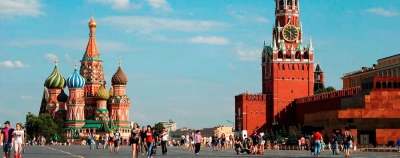
Moscow’s Red Square (Krasnaya Ploshchad) is known for its political symbolism, but was actually named for its loveliness: Krasnaya, or “red,” meant “beautiful” in old Russian.
The plaza has drawn crowds since it was a 1400s shantytown. Russians know the square as the front yard of rulers from Ivan the Terrible to Vladimir Putin. Westerners are apt to recall the Cold War’s lock-stepping armies. Along with Moscow’s great architectural jewels, including the crenellated Kremlin walls and St. Basil’s onion domes, Red Square remains the beating heart of Russia.
The square’s name has nothing to do with communism or with the colour of many of its buildings. In fact, it comes from the word ‘krasny’, which once meant ‘beautiful’, and has only come to mean ‘red’ in contemporary Russian. The name became official in the middle of the 17th century – previously, it had been Trinity Square, due to the Trinity Cathedral, the predecessor of St Basil’s.
Red Square came into its own in the 20th century, when it was most famous as the site of official military parades demonstrating the might of the Soviet armed forces to the world. Two of these will be remembered forever. The first was the parade of 7 November 1941, when columns of young cadets marched through the square and straight on to the frontline, which by that point was less than 50km from Moscow. The second was the victory parade on 24 June 1945, when two hundred Nazi standards were thrown in front of the mausoleum and trampled by mounted Soviet commanders.
Since Perestroika, the emphasis has moved away from official events, and Red Square has been used increasingly for rock concerts, major classical music performances and a whole range of large-scale events from fashion shows to festivals of circus art. Moscow welcomed in the millennium here with a huge firework display and street party.
Credit : Russian National Tourist Office
Picture Credit : Google




